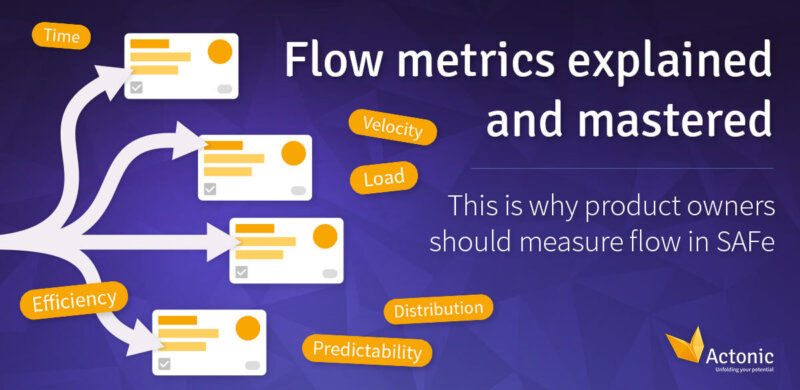Providing context to work while tracking velocity, efficiency, and improvement will help all teams working on related projects get out of their silos and become truly agile. Especially the Product Owner, who plays a critical role in maximizing the value of the product and the overall agile team as the voice of the customer, will benefit from flow measurements in SAFe.
In this article, we’ll explain several metrics of the flow framework that illustrate the importance of measuring flow, and discuss the responsibilities of a SAFe Product Owner and their role in enhancing team agility through Jira reporting.
SAFe 5.1 – The Flow Framework
In its fifth iteration, SAFe added a flow-based system, emphasizing the importance of measuring flow via a comprehensive Flow Framework.
The flow framework provides six flow metrics to address critical DevOp concerns like overload, interruptions, and delays due to scope creep. It also helps measure organizational efficiency while delivering value to customers.
The six metrics for measuring your flow are the following:
-
Flow Velocity calculates value delivery increase by measuring the number of backlog items completed over a precise period. Higher velocity equals higher output and is an excellent indicator of process improvements being applied to provide value to customers.
-
Flow Distribution ensures all product value streams have a dynamic mix of flow items like features, defects, risks, and debts to maintain flow velocity and deliver current and new value to customers.
-
Flow Time is an indicator of speed and predictability. But instead of a developer-centric measure of time, this metric is customer-centric. Flow Time tracks the amount of time for work to be completed once it enters the value stream. Analysing this data enables forecast and improves time-to-market, customer relations and retention, and supports the company’s inaccurate financial planning.
-
Flow Load measures the number of active flow items currently in development. This metric helps teams limit the number of active items to enable a fast flow of value, improving flow time and flow velocity.
-
Flow Efficiency indicates the amount of flow time spent in value-addition work versus waiting between steps. It helps identify waste and delays that decrease flow velocity.
-
Flow Predictability measures how well ART teams and Solution Trains plan their Program Increment (PI) objectives by comparing the planned business value to actual delivered business value. Low or inconsistent predictability identifies underlying technical, planning, or organizational barriers and helps address them. Measuring predictability enables teams to manage expectations with technology and business about how much they can deliver and when.
How to apply your flow metrics in Jira
Jira is the most common tool used by agile Teams, and SAFe Product Owners can get an agile overview of the entire project. The six metrics of the Flow Framework have proved the importance of measuring progress in SAFe. Jira time tracking apps such as Timesheet Builder allow teams to log time for Jira issues and projects, which can be utilized to get an overview of tracked time, forecast workload, and manage capacity.
With other apps, such as Report Builder, Product Owners can gain detailed insights into team capacity, understand overload, and other issues that affect flow time, velocity, and efficiency. Most SAFe Product Owners face challenges like reporting and visibility. These issues can easily be resolved with this no-coding Jira reporting app.
These two apps help you to:
With Timesheet Builder & Report Builder, Product Owners can efficiently plan resources, identify roadblocks, resolve them and track SAFe and agile Project Management metrics to increase agile team efficiencies in real-time. The tools allow an agile view of the project, so you can easily optimize value during program execution and program increment planning.
Increase stakeholder engagement with flow metrics
Stakeholder management is also an important responsibility of a SAFe Product Owner. With the Report Builder, Product Owners can accurately represent the work of Agile teams and increase stakeholder engagement.
In addition, Product Owners can easily create visual reports of dependencies and timelines or any custom Jira report without extracting and manipulating data from Jira on Excel sheets, saving SAFe Product Owners a lot of time and simplifying SAFe implementation.
Report Builder empowers Product Owners and helps them bridge the gap between agile teams and stakeholders through increased project visibility and enhanced communication between teams, management, customers, and stakeholders.
You can also confidently implement flow metrics in Jira with the unbeatable project management tool duo: Timesheet Builder and Report Builder.
Try them now!

